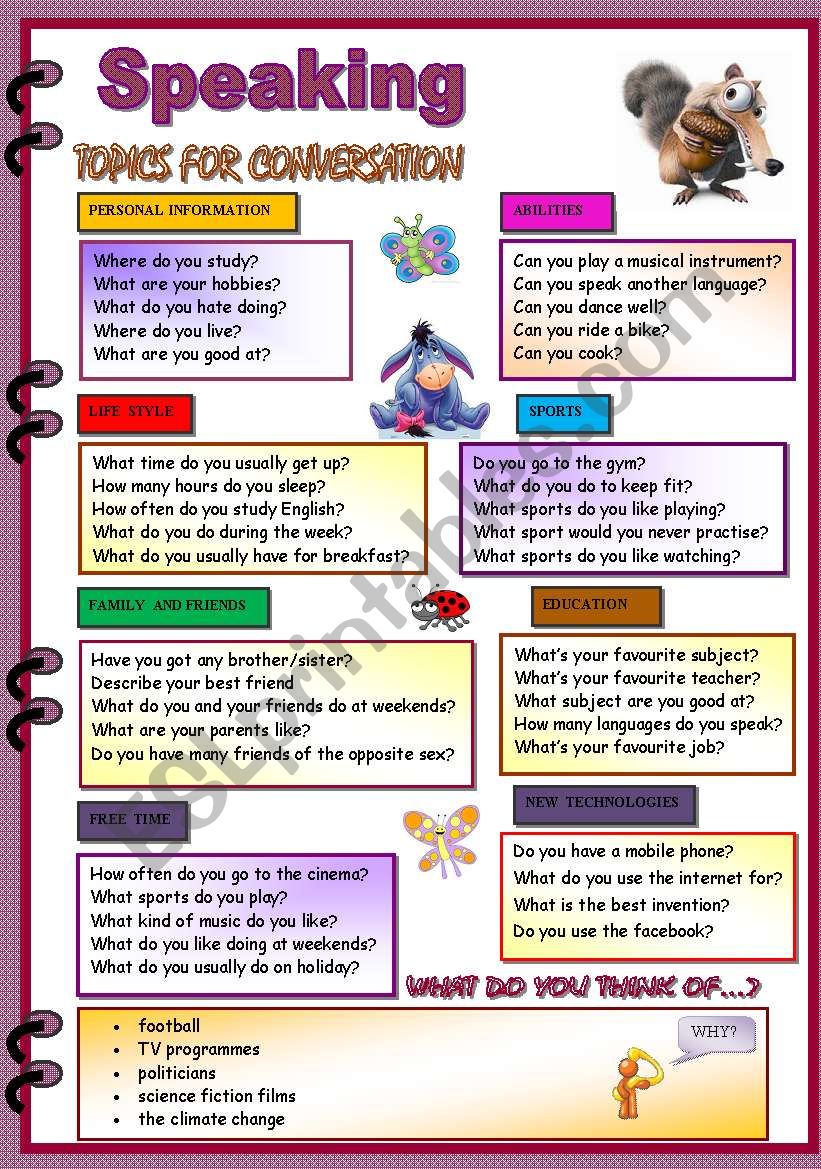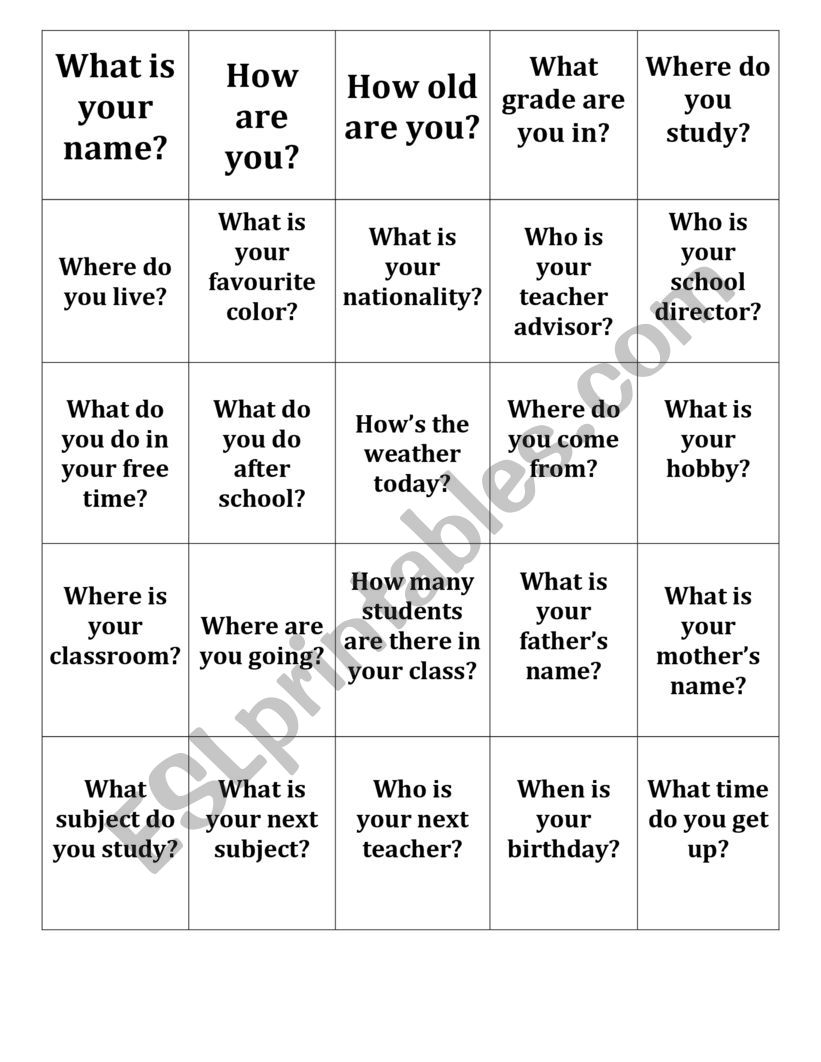
Unlocking Fluency: The Power of Conversation Questions for ESL Worksheets
In the dynamic world of English as a Second Language (ESL) teaching, the ultimate goal is not merely grammatical accuracy or extensive vocabulary, but genuine, confident, and spontaneous communication. While textbooks and grammar drills lay crucial foundations, true proficiency blossoms through active verbal engagement. This is where conversation questions for ESL worksheets emerge as an indispensable tool, transforming passive learners into active communicators. Far from being simple prompts, these carefully crafted questions serve as catalysts for language acquisition, critical thinking, and cultural exchange, offering a direct pathway to fluency.
The Indispensable Role of Conversation Questions
The strategic use of conversation questions in ESL classrooms offers a multitude of benefits that extend beyond basic language practice:

-

Promoting Fluency and Spontaneity: The primary aim of conversation questions is to encourage students to speak without overthinking. Unlike structured grammar exercises, they demand immediate responses, forcing learners to retrieve vocabulary and construct sentences in real-time. This repeated practice builds neural pathways that lead to more fluid and natural speech.

-
Building Confidence and Reducing Affective Filter: Many ESL learners, especially beginners or those from cultures where making mistakes is heavily frowned upon, suffer from a high "affective filter" – a psychological barrier that inhibits language production. Well-designed conversation questions, especially when used in a supportive classroom environment, create a safe space for experimentation. The focus shifts from perfect grammar to conveying meaning, gradually chipping away at inhibitions and boosting self-assurance.
-
Contextualizing Vocabulary and Grammar: While vocabulary lists and grammar rules are essential, their true value is unlocked when applied in context. Conversation questions provide natural scenarios where students can actively use new words and grammatical structures, solidifying their understanding and retention. For instance, questions about future plans necessitate the use of future tenses, making the learning organic and memorable.

-

Stimulating Critical Thinking and Opinion Formation: Beyond simple recall, effective conversation questions push students to think critically, form opinions, and articulate their reasoning. Questions like "Do you agree or disagree with…?" or "What are the pros and cons of…?" encourage deeper cognitive engagement, helping students develop higher-order thinking skills in English.
-
Facilitating Cultural Understanding and Exchange: Language is inextricably linked to culture. Conversation questions that touch upon customs, traditions, societal norms, or personal experiences provide a rich platform for students from diverse backgrounds to share their perspectives. This not only broadens their worldview but also enriches their vocabulary related to social and cultural topics.

-
Personalizing the Learning Experience: When questions relate to students’ lives, interests, hobbies, or aspirations, the learning becomes highly personal and engaging. This relevance increases motivation and makes the practice feel less like a chore and more like a genuine interaction.



Crafting Effective Conversation Questions for ESL Worksheets
The effectiveness of conversation questions for ESL worksheets hinges on their design. Not all questions are created equal. Here are key principles for crafting impactful prompts:
-
Prioritize Open-Ended Questions: Avoid "yes/no" questions that lead to dead ends. Instead, opt for questions that require more elaborate answers, encouraging detailed explanations, justifications, and follow-up thoughts.
- Closed: "Do you like coffee?"
- Open: "What do you like about coffee, or what kind of drinks do you prefer and why?"
-
Ensure Relevance and Relatability: Questions should resonate with students’ experiences, age group, and potential interests. Topics like daily routines, hobbies, travel, food, family, and future plans are often safe and engaging starting points.
-
Match to Proficiency Level: Questions must be challenging enough to encourage growth but not so difficult that they overwhelm students. Vocabulary, grammatical complexity, and abstractness should be carefully scaled to the target proficiency level (beginner, intermediate, advanced).
-
Promote Variety: Mix question types to keep the conversation dynamic. Include questions that elicit personal anecdotes, opinions, hypothetical scenarios, problem-solving ideas, and comparisons.
-
Maintain Clarity and Simplicity: Use clear, unambiguous language. Avoid jargon, overly complex sentence structures, or idiomatic expressions that might confuse learners, especially at lower levels.
-
Encourage Follow-Up: Design questions that naturally lead to further discussion. For example, after asking "What’s your favorite season?", a good follow-up would be "Why do you like it, and what activities do you usually do during that time?"
Categorizing Conversation Questions for Diverse Learning Needs
To ensure comprehensive language development, it’s useful to categorize conversation questions for ESL worksheets based on the type of interaction or cognitive skill they aim to develop:
- Personal/Getting-to-Know-You Questions: Ideal for warm-ups or icebreakers. (e.g., "Tell me about your typical day," "What’s one thing you’re passionate about?")
- Opinion-Based Questions: Encourage expressing personal viewpoints and supporting them. (e.g., "Do you think social media is good or bad for society? Why?", "What’s your opinion on remote work?")
- Hypothetical Questions: Promote creative thinking and use of conditional tenses. (e.g., "If you could travel anywhere in the world, where would you go and why?", "What would you do if you won the lottery?")
- Problem-Solving Questions: Engage critical thinking and collaborative discussion. (e.g., "How can we encourage more people to recycle?", "What are some solutions to traffic congestion in big cities?")
- Narrative/Experience Questions: Prompt storytelling and use of past tenses. (e.g., "Describe a memorable trip you’ve taken," "Tell me about a time you faced a challenge and overcame it.")
- Cultural Comparison Questions: Foster cross-cultural understanding. (e.g., "How are holidays celebrated in your country compared to others?", "What are some common gestures in your culture?")
Implementing Conversation Questions in the ESL Classroom
Simply handing out a worksheet is not enough. Effective implementation is key to maximizing the benefits of conversation questions:
-
Preparation is Key: Before diving into a discussion, pre-teach any challenging vocabulary or grammar structures that might arise. Brainstorming related ideas as a class can also help activate prior knowledge.
-
Pair and Group Work: This is often the most effective setup for maximizing speaking time. Students feel less pressure than in a whole-class setting, and everyone gets a chance to speak. Rotate partners regularly to expose students to different accents and communication styles.
-
Teacher as Facilitator, Not Interrogator: Your role is to guide, prompt, and encourage, not to dominate the conversation. Listen actively, provide scaffolding when needed, and gently correct errors without interrupting the flow too much. Note down common errors for later review.
-
Vary Activities: Don’t just stick to Q&A. Use questions for debates, role-plays, mini-presentations, or even "speed dating" style conversations where students rotate every few minutes.
-
Provide Follow-Up Activities: Extend the learning beyond the conversation. Students could write a summary of their discussion, journal about their opinions, or prepare a short presentation based on the questions.
-
Error Correction Strategy: Decide on a clear error correction strategy. For fluency activities, it’s often best to let students speak and note down major errors for a feedback session afterward, rather than interrupting constantly. For accuracy-focused activities, immediate correction might be more appropriate.
Common Pitfalls to Avoid
Even with the best intentions, teachers can fall into traps when using conversation questions:
- Using Too Many Closed Questions: As mentioned, these stifle conversation.
- Lack of Pre-Teaching: If students don’t have the necessary vocabulary or grammar, they’ll struggle and become frustrated.
- Teacher Dominance: The teacher talks too much, leaving little speaking time for students.
- Ignoring Mistakes Entirely (or Over-Correcting): Find a balance. Provide constructive feedback without discouraging participation.
- Lack of Follow-Up or Purpose: If questions feel isolated and don’t lead to further learning or application, their impact diminishes.
Adapting for Different Proficiency Levels
The beauty of conversation questions for ESL worksheets lies in their adaptability:
- Beginner Level: Focus on simple present tense, concrete topics, and personal information. Use visuals if possible. (e.g., "What is your favorite color?", "Do you have any pets?", "What do you eat for breakfast?")
- Intermediate Level: Introduce more complex tenses (past, future, present perfect), conditional sentences, and topics requiring simple opinions or descriptions. (e.g., "What did you do last weekend?", "If you could learn a new skill, what would it be?", "Describe your ideal vacation.")
- Advanced Level: Challenge students with abstract concepts, ethical dilemmas, nuanced opinions, and complex grammatical structures. Encourage them to justify, analyze, and synthesize. (e.g., "Discuss the ethical implications of AI," "How has globalization impacted your culture?", "What are the biggest challenges facing our planet and how can individuals contribute to solutions?")
Integrating Conversation Questions with Other ESL Skills
Conversation questions are not standalone. They can be seamlessly integrated with other language skills:
- Listening: Students actively listen to their partners’ responses, practice comprehension, and formulate follow-up questions.
- Reading: Questions can be based on a short text, article, or story, encouraging deeper understanding and discussion.
- Writing: Students can write about their answers, summarize a discussion, or prepare a short essay based on a conversation topic.
- Vocabulary and Grammar: The conversation itself provides a natural context for using new vocabulary and grammatical structures, making them more memorable and functional.
Conclusion
In conclusion, conversation questions for ESL worksheets are far more than just a supplementary activity; they are the heart of communicative language teaching. They offer a structured yet flexible framework for students to practice, experiment, and ultimately master the art of English conversation. By thoughtfully designing, implementing, and adapting these questions, educators can empower their students to overcome linguistic barriers, build confidence, and engage meaningfully with the world in English. The journey to fluency is paved with consistent, engaging, and purposeful conversation, and these questions are undoubtedly one of the most effective tools in the ESL teacher’s arsenal.
